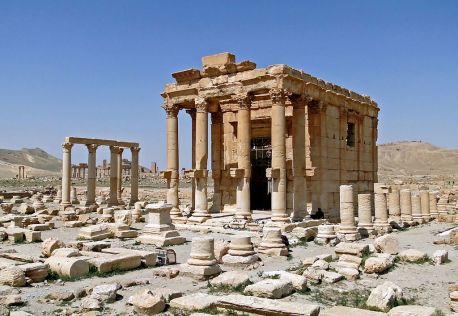
Robin Yassin-Kassab
"When Daesh destroys Baal’s temple, when the regime destroys the Zabadani mosque (or Aleppo’s Umawi mosque, or Deraa’s Omari mosque), it’s as if fascist forces have destroyed Stonehenge, Westminster Abbey or the Tower of London, as if the British Library and British Museum have burnt. It declares a total rupture with the past.
All borders are acts of the imagination, and the Sykes-Picot borders are more artificial than most. They were drawn by foreign imperialists – either clumsily or maliciously, according to your reading – and manifested an order in which minorities wielded power over majorities.
The dissolution of these false borders would of course be welcome if it implied a dissolution of repressive state structures (and foreign interference), and a corresponding empowerment of individuals and communities. It would be welcome if it ended the political exploitation of sect. But both Assad and Daesh offer the opposite, and neither of their projects can provide stability. At once a perverse reincarnation of Baathist tyranny and a homeland for international fantasists, the Daesh state is a temporary phenomenon, a parasite feeding on Assad’s war. And Assad’s shrinking state is an Iranian puppet; running low on Syrian manpower, it implements a foreign agenda.
This has never been clearer than today. When negotiations were held over Zabadani, the Islamist militia Ahrar al-Sham spoke on behalf of the rebels. Its interlocutor was not the Syrian regime, but the Islamic Republic of Iran. Ahrar hoped to win a mutual ceasefire from the negotiations – that Hizbullah stop attacking Zabadani, and the rebels in return stop attacking Fu’ah and Kafraya, pro-regime Shia towns in Idlib province. But Ahrar broke off talks when the Iranians demanded instead a population exchange – that Sunni residents leave Zabadani, and Shia residents leave Fu’ah and Kafraya.
Having failed to hold most of Syria, Assad and the Iranians aim now to retrench in an area stretching from the coast through Homs along the Lebanese border to Damascus. This is their version of what the French occupiers called ‘la Syrie utile’. The sectarian cleansing of strategic zones in this area began in 2013 (especially around Homs), and continues with the current assault on Zabadani and the increased aerial bombardment of the Ghouta suburbs of Damascus, already subjected to sarin gas, artillery barrages and two years of starvation siege. On August 16th, for example, barrel bombs murdered over a hundred people in a Douma marketplace.
It goes on day by day – Syria’s present, past and future dissolve, and the world participates in the tragedy. Britain reopens its embassy in Tehran. The UN sups with Assad. The US, long retreated from its anti-regime threats, bombs moderate Islamist opposition groups like Jaish al-Sunna as well as Daesh. Worse, it seems the Americans are using their involvement in the multinational operations centre in Jordan to hold back the Free Army’s Southern Front from victory in Deraa."
No comments:
Post a Comment